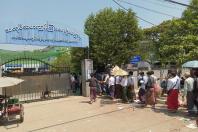When Xing Shangzhi, a farmer in his late 40s, herds his sheep and tends his potato plots along a hillside in Dazhaizi village, Fuxian, Shaanxi province, he often comes across rubble consisting of bricks and tiles that date back centuries. That fact is obvious from their shape and pattern, both of which are unusual today.
Like many local people, Xing and his wife live in a dwelling dug out of the hillside below the Ziwu Range. The ridge of the range, which runs from south to north in the western part of Shaanxi over a distance of about 413 kilometers, is unusually solid, making it ideal for the excavation of cave dwellings.
Yet unlike the Great Wall and the Terracotta Warriors, which have long been regarded as symbols of China and listed as part of world's cultural heritage by UNESCO, most sections of the Qinzhidao are forgotten, buried in wild grass
Other farmers and herdsmen living along the range in several counties often find similar treasures, including earthen pipes and ancient coins of various shapes.
If that was not enough, unlike other local mountain ranges, whose ridges are often shaded by thick woodland, the ridge of the Ziwu Range is either covered by short grasses or is bare, making it look like a 10-to-60-meter-wide belt meandering along the length of the range.
For generations, the ridge has not only served as an ideal roof for cave dwellings, but also as a natural dirt road; sturdy and reliable.
READ MORE: Restoring color to China's Terracotta Warriors
Although the Ziwu Range is in the center of the Loess Plateau - an area the size of France, covered with layers of fertile soil dozens of meters deep blown from deserts in the north and west over millions of years - the soil of the ridge seems light and flimsy, meaning large plants are unable to lay deep roots.
That flimsiness is the result of an intermediate layer of extremely compact earth, about 1 or 2 meters thick, which is a lighter color than the yellow earth in which it is sandwiched.
It is in this soil layer that farmers unearth the rubble that can only have belonged to urban dwellers, and the strong layer below it, usually mixed with gravel, serves as a roadbed for the dirt path that follows the ridge of the Ziwu Range.
ALSO READ: Experts to repair warrior's thumb

A monument marks the starting point of the ancient "Straight Road" in Liangwudi village, Xunyi county, Shaanxi province. (REN BAOJUN / CHINA DAILY)
Noble's Belt
"Senior villagers call the dirt path 'the Noble's Belt' or 'the Emperor's Route'," Xing said. "It is probably part of the old Qinzhidao, which has been lost for a long time."
To locals, the Qinzhidao, or "Straight Road" of the Qin Dynasty (221-206 BC), is a legendary engineering wonder, equal to the Great Wall and the Terracotta Warriors. Yet unlike those relics, which have long been regarded as symbols of China and listed as part of world's cultural heritage by UNESCO, most sections of the Qinzhidao are forgotten, buried in wild grass.
The annals of Sima Qian, a historian of the early Han Dynasty (206 BC- 220) who traveled the Straight Road, are the earliest and most detailed records of the road, and they are still consulted by most researchers of this magnificent project.
According to Sima Qian, the road stretches about 800 kilometers north from Liangwudi village in Chunhua county, Shaanxi, to Baotou in the Inner Mongolia autonomous region
According to Sima Qian, the road stretches about 800 kilometers north from Liangwudi village in Chunhua county, Shaanxi, to Baotou in the Inner Mongolia autonomous region.
Qin Shihuang, who founded the Qin Dynasty after conquering six other major kingdoms, ordered General Meng Tian to build a road connecting the Guanzhong Plain - the Qin's heartland - with the Great Wall in the north.
Although it should have been a time to give the people a period of rest after years of war, the Qin rulers forced them to undertake grand projects, including building a road network of 6,437 kilometers within a short time, among which the Qinzhidao was the most important.
The highway was intended to facilitate the transportation of soldiers and provisions to the borders of the nomadic peoples, and also to make the emperor's inspection tours of the dangerous north more convenient.
Leading 300,000 of Qin's best troops, Meng started work on the project, supervised by Fu Su, the emperor's oldest son. However, the work only lasted about two years after Qin Shihuang's sudden death in 210 BC prompted a palace coup.
Meng and Fu were purged and both died in 210 BC. They were buried in Suide county, Shaanxi, not far from the road, where they were honored by local people.
Ironically, the only time Qin Shihuang used the road was when his body was transported back to Xianyang, the Qin capital. The dynasty was overthrown by a peasant uprising a few years later.
"It is no surprise that many of Qin's grand projects, which were built to promote lasting peace and the stability of the Qin (Dynasty), expedited its collapse," said Zhang Xiaobing, a professor of history at Yan'an University in Shaanxi.
Zhang conceded that his opinion echoes that expressed by Sima Qian in his annals after he visited the Qinzhidao with the seventh emperor of the Han Dynasty in 110 BC.

Lovers of Qinzhidao drive along the ancient road in Fangjiahe village, Gangquan county, Shaaxi province, on March 19, 2019. (PHOTO / CHINA DAILY)
"The Qin rulers' desire for greatness and success left so many engineering wonders for future generations, but it also doomed them," he said.
Work on the Straight Road was largely suspended, though its main parts were completed, leaving an even road with an average width of about 50 meters, with dozens of courier stations, passes and fortresses built along its length, most of which are ruins today.
'Cooked soil'
The ridge of the Ziwu Range is generally even, and the builders tried their best to make the slopes gentle, the road straight and its surface sturdy.
It is said that the mixture used to construct the roadbed included gravel and large amounts of "cooked soil" - earth heated to a high temperature, partly to kill off all flora and fauna - with rice milk used to glue it all together.
Stone rollers were then used to make the road surface even and compact. To prevent landslides, the builders paid special attention to reinforcing the roadbed and the slopes, and they employed s-bends to minimize the gradient during ascents and descents.
Basically, the Qinzhidao is like an expressway, although primarily for military use, in the modern sens
Ren Baojun, photographer
Where the Ziwu Range ends at the northern border of the Loess Plateau, the road continues through the Erdos Plateau, the Kubuqi Desert and the Hetao Plain, and meets a fortress affiliated to the Great Wall at the foot of the Yinshan Range in Inner Mongolia.
"Basically, the Qinzhidao is like an expressway, although primarily for military use, in the modern sense," said Ren Baojun, a photographer in Chunhua who has been taking photos of the ruins along the road for many years.
"Whenever I walk on it, I am astonished by the perseverance and skill of the Qin people. It is hard to imagine how they finished all of this with just manpower and livestock," he said.
Wang Zijin, a historian who specializes in studies of the Qin and Han dynasties at Renmin University of China in Beijing, said that as it overlooks the valley on either side of the Ziwu Range - the main route for invaders from the north - the road could serve as a defensive fortification for Xianyang, in the event of enemy forces breaching the Great Wall.
The road played an important role in maintaining the stability of the north during the Han Dynasty, giving potential invaders cause to think twice because of the ruler's ability to send quick-response forces via the road.

Wang said: "The Great Wall is like a shield, while the Straight Road is like a spear. And if the Great Wall is a bow, the Straight Road is an arrow."
According to He Yiping, curator of the museum of Xunyi county, Shaanxi, the Qinzhidao was used at least twice in the Han Dynasty and the Tang Dynasty (618-907) to help transport large numbers of troops from Central China to fight against invaders from the north.
He Yiping often arranges for people interested in the Qinzhidao to hike along the ancient road. "Not many people have walked on the road over the past few decades, which has helped to protect it. The ancient ditches, tombs and smoke towers are largely well protected, hidden in grasses and forests," He said.
An enduring puzzle
It remains a puzzle how Meng and Fu could complete so much in just two years. Despite the road being unfinished, it only took about three days for the Qin army and its supplies to reach the north, as opposed to two weeks in the days before the highway existed.
Zhang Haibin, a researcher at the Cultural Relics Administrative Department of the Baotou government, said the road allowed large numbers of people from the south to settle on the Hetao Plain, increasing the leverage of the Han people in a region where the Mongolian and Hui ethnic groups previously dominated.
Qinzhidao increased the leverage of the Han people in a region where the Mongolian and Hui ethnic groups previously dominated
The road was in use until the end of the Qing Dynasty (1644-1911). Over the course of more than 2,000 years, it served as a transportation artery for commercial, cultural and religious exchanges between Han farmers in the south and the nomadic peoples of the north.
Wang Junmin, a farmer in Liangwudi village, the road's starting point, said: "Although the Qinzhidao is largely deserted nowadays, it is still alive in the lives of the local residents. Many of our houses and yards were built with ancient bricks and tiles found near it. They are of good quality and are ideal building materials, even today."
Liu Hulin, a painter and chairman of the Ganquan county Federation of Literary and Art Circles who has been inspired by many trips along the ancient road, said: "Farmers have lived near the Qinzhidao for generations, and their lifestyle, construction technologies and even language are unique. For instance, the way they build a house and courtyard, and some of their vernacular language can be traced to the Qin and Han dynasties."
Archaeologists were not really aware of the road until 1962, when a national newspaper published a local reporter's essay on the subject.

Ren Baojun, a photographer from Chunhua, points to the ruins of the roadbed of the Qinzhidao in Liangwudi village, the starting point of the road, on April 14, 2019. (PHOTO / CHINA DAILY)
In the mid-1970s and late 1980s, a number of archaeologists, historians and artists organized field research tours along what remained of the road. Their findings largely accorded with Sima Qian's records and confirmed the existence and the main route of the legendary thoroughfare.
Zhang Zaiming, an archaeologist with the Shaanxi Academy of Archaeology, told China Central Television: "These (the findings) are apparently not enough to highlight the importance of the road. Academically, it takes more concrete and professional archaeological findings, which would be complicated and costly, to match the Qinzhidao with its status in history."
In the 1990s and the first decade of this century, Shaanxi, Gansu and Inner Mongolia - the three provincial-level regions the road traverses - put certain sections of the Qinzhidao within their jurisdictions under government protection, and turned some into tourist attractions.
Despite those moves, much of the once-busy road remains asleep under the grass, largely unknown to most people.
https://www.chinadailyhk.com/articles/83/190/195/1556789823401.html










